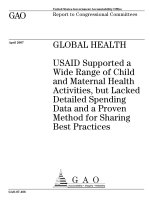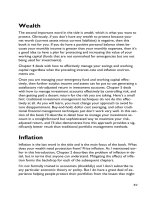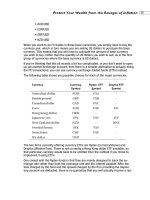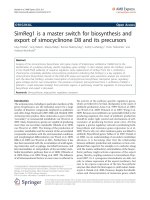everyone is a customer a proven method for measuring the value of every relationship in the era of collaborati phần 7 ppt
Bạn đang xem bản rút gọn của tài liệu. Xem và tải ngay bản đầy đủ của tài liệu tại đây (364.55 KB, 24 trang )
rence). Webster’s Dictionary defines bootstrapping as “promoting
or developing by initiative and effort with little or no assistance.”
And that’s essentially what we’re talking about: creatively devis-
ing how to parlay non-cash currencies into what you need to
achieve your goals. In a corporate setting this is often referred to
as “leveraging assets.” In other words, you’re trying to use what
you have and gain access to what you need but don’t have. Either
way, you’re bootstrapping.
Now that you know the currencies you need, assume that
the filtering of the 350 names we discussed in Chapter 6 is based
on the goals you identified in Figure 7.3. In our example, this fil-
tering resulted in 50 Scenario A–D relationships. The next step is
to analyze the currencies each of these relationships offers rela-
tive to the currencies required to achieve your goals. Let’s exam-
ine the process in detail for just a few of these 50 relationships.
Sharon Smith. You’ve done Sharon Smith’s tax return for
three years. During the past year you’ve helped her with some
120 Part Two
❘
Purposeful Collaboration
FIGURE 7.4
❘
Your Currency/Goal Linkage Table
financial planning decisions as she quickly rose to become a vice
president at one of the largest advertising and public relations
firms in the city. But advertising has been significantly affected by
the downturn in the economy and Sharon was recently laid off.
For Sharon, this turn of events represents the opportunity to be-
come the choreographer of her own business. She comes to you
because she needs your expertise and also because you have lots
of customers she hopes can become her customers. She doesn’t
have a lot of money, but she has thought about your business, the
manner in which you communicate with customers, and how she
can help you do so more effectively. She hopes she’ll soon have
lots of customers that can become your customers, and she wants
to work out a trade. What do you do? You answer the four ques-
tions for Sharon as shown in Figure 7.5. Referring back to Figure
6.1 (The Four Questions), you conclude that Sharon fits into Re-
lationship Scenario C—Potential Collaborative Opportunity.
Len Collins. Len is a senior vice president in the largest bank
in your city, and his brother is managing director of an important
venture capital firm. You and Len meet for lunch once or twice a
year, run into each other at networking events, and occasionally
get together in a foursome during charity golf outings. Len always
7
❘
Measuring the Value of Every Relationship 121
FIGURE 7.5
❘
Evaluating Relationships
makes it a point to introduce you to the people he knows on
these occasions, and several have become personal tax clients.
However, he hasn’t referred any of his business customers to
you, nor can you really think of anyone you’ve introduced to
him that has become a customer of his bank. You believe your re-
cent promotion to partner will change that. Again, what do you
do? You enter your answers to the four questions for Len in Fig-
ure 7.5, concluding that he fits into Relationship Scenario D—
Collaborative Opportunity.
Stephen White. You and Stephen serve together on the
board of a local not-for-profit. He is a very successful condo-
minium developer who buys up and renovates older buildings
in city neighborhoods. Because, like politics, real estate is local,
Stephen is very well connected to city government, local finan-
cial institutions, and the media as well as to prominent members
of the community. You’re currently doing the tax work on a few
of his developments, but he lowballs you on price. Always one
to ask the quick question, Stephen seems to get the information
he needs without incurring costs. What do you do? You enter
your answers to the four questions for Stephen in Figure 7.5,
concluding that Stephen is a Relationship Scenario B—Critical
Collaborative Opportunity.
Clearly, each of these people represents an important rela-
tionship for someone trying to achieve goals such as yours. But
who offers greater value? All have their positives and negatives.
Stephen’s contacts within local financial institutions may be bet-
ter than Len’s, but Stephen has yet to offer an introduction. Len
has access to a circle of people different from Stephen’s, includ-
ing the type of technology companies that will help you achieve
Goal 3. Sharon is already a client with access to an entirely dif-
ferent group of possible customers, and her services can benefit
your goal of reducing communication costs. Looking at both
current and future Relationship Scorecards for each will help an-
swer who is of greater value to you.
122 Part Two
❘
Purposeful Collaboration
DIGGING DEEPER
Let’s start with Sharon. Currently, she is a personal tax
client, but that relationship is a non-core, transactional one. She
is not presently providing you with any currencies to help you
achieve your newly assigned goals. Thus, her Current Relation-
ship Value is 0. But you think she could offer you currencies as
her business gets going, and you know you can introduce her to
the potential customers she wants. To calculate her Future Rela-
tionship Value, let’s run through the currencies you need and see
what your relationship with Sharon can provide. Keep in mind
that the future we are referring to is based on your year time
frame for achieving your goals:
• Cash—She is looking to trade with you and not provide
cash.
• Customers—Sharon is just starting out, so she doesn’t qual-
ify as the type of customer you want under Goal 1. She is
already a personal tax client, so she doesn’t influence Goal
2. Her financial information system needs are quite sim-
ple, so she doesn’t represent the customer you are looking
for under Goal 3. So you conclude she doesn’t fit into the
category of any “actual customers” you are presently
seeking. Sharon is what we’ve described as a transactional
customer.
As a plus, Sharon has offered to introduce you to her
future customers. You know that in the past she has
worked with businesses that would need planning, tax,
and audit services, but her contacts are with people in
marketing, not finance. So even though she may offer you
information about businesses that meet your criteria, you
decide to assign her a utility of “Low.” Thus, enter a 1 in
the Goal 1 column. You really don’t see how Sharon can
assist with Goal 2, so you skip that column and assess
7
❘
Measuring the Value of Every Relationship 123
whether she can help you with Goal 3. Here you decide
she will, in fact, have access to many companies that fit
this category. She plans to work with emerging technology
companies that grow quickly, are often backed by venture
capital, and thus need good, solid financial information
systems. And because with smaller companies she tends
to interact with the principals, you rate the utility of her
access as “Medium.” Thus, enter that value (the 3 repre-
senting medium utility/access to) in the Goal 3 column.
• Products and services—Instead of giving you cash for your
services, Sharon is offering you her services to help your
firm become more effective and efficient in communicat-
ing with your customers. Because you know the quality
of her work and the results she has obtained for some of
her customers at her former firm, you decide this actual
currency is of medium utility. Thus, you enter that value
in the Goal 4 column.
You don’t believe Sharon offers any of the other currencies
you require, so you calculate the weighted totals thus:
Goal 1: 1 × .35 = .35
Goal 2: 0 × .15 = 0
Goal 3: 3 × .30 = .9
Goal 4: 4 × .20 = .8
And then sum the column totals (.35 + 0 + .9 + .8) to get Sharon’s
Future Relationship Value of 2.05, as shown in Figure 7.6.
Before you make any decisions about Sharon’s Relationship
Value, move on and complete the scorecards for Len and
Stephen. When you think about the currencies Len offers and
how they help you achieve your goals, you come to the follow-
ing conclusions and complete his scorecards accordingly. Many
of Len’s business customers fit the criteria you’ve set for Goals 1
and 3, but those aren’t the introductions he tends to make. So
124 Part Two
❘
Purposeful Collaboration
that currency isn’t immediately available. He does give you ac-
cess to certain individuals who have become personal clients, so
you assign a medium value to this access and enter that value in
the customer line in the Goal 2 column (Figure 7.7). Although it
7
❘
Measuring the Value of Every Relationship 125
FIGURE 7.6
❘
Sharon Smith’s Scorecard
is nice to be known as a friend of Len’s, you don’t see how this
validation is currently helping you with any of your goals. Next,
you recall that you met the tax manager your firm just hired dur-
ing one of his charity golf events. The tax manager helps you in
offering the full services envisioned under Goal 1. You decide
this is low value for access and place that value on the compe-
tencies line. You total up your scorecard to discover that Len’s
Current Relationship Value is 1.15.
As you think more about the relationship, you realize that
you haven’t really offered any of your currencies to Len. Maybe
that’s why the relationship isn’t intensive. You recognize there
are many things you can do to bring customers to Len, which
you assume is an important goal for him. But just to be clear
what you should offer, you look at the currencies you believe
Len has available and carefully complete a scorecard for his Fu-
ture Relationship Value.
As you think about the currencies Len could offer, you de-
termine the following:
• Customers—Len can provide you with access to cus-
tomers across all three of your customer acquisition
goals. You know he’s well respected, and bankers are
generally good referral sources for accountants, so across
Goals 1–3, you assess the utility of his access to cus-
tomers as “High.”
• Products and services—For the customer base you intend
to service, information about sophisticated banking
products can be important. Consequently, you decide
that Len can offer you information about products and
services that has a utility rating of “High.”
• Competencies—Len’s brother is a venture capitalist, and
some of the customers you seek will want to obtain this
type of financing. Thus, he offers you information about
a competency that may help you in attaining customers
126 Part Two
❘
Purposeful Collaboration
7
❘
Measuring the Value of Every Relationship 127
FIGURE 7.7
❘
Len Collins’s Scorecards
who fall under either Goals 1 or 3. You value that utility
as “Low,” because your relationship is with Len, not with
his brother. Of course, you would still have access to the
type of contacts that brought your tax manager, but you
decide to conservatively value this currency.
• Validation—You know Len has offered workshops on fi-
nancial planning jointly with at least one other CPA firm.
If he’d be willing to work with you and your firm to offer
such a program, you believe that would provide you
with actual validation of your firm’s expertise. Len is an
important figure in the business community, so you de-
cide that validation would be of medium value in achiev-
ing Goal 2; thus you enter a 4 in that cell.
You leave the next three rows blank, recognizing that while
Len may offer you information about technology or an introduc-
tion to a customer who has information you can use to reduce
your communication costs, as per Goal 4, you haven’t identified
anything specific. Now you calculate the weighted totals (Goal 1:
(4+3+1) × .35 = 2.8; Goal 2: (4+3+4) × .15 = 1.65; Goal 3: (4+3+1) ×
.3 = 2.4) and sum up the scorecard (Figure 7.7) and determine
Len’s Future Relationship Value is 6.85 = (2.8 + 1.65 + 2.4). This
validates your intuitive understanding of Len’s Future Relation-
ship Value (much greater than Sharon’s), but it unnerves you a lit-
tle. Unless you can offer Len something of value and increase the
rhythm of the relationship, his currencies—present and future—
may be lost. As we’ve said, one-way relationships don’t last.
Next you turn to Stephen. He certainly isn’t one of your fa-
vorite customers, as he always seems to have the upper hand
and is demanding of your time. However, he’s so well connected
and successful, it is worth trying to find a way to make this a
win-win relationship.
Thinking about the currencies Stephen provides, you real-
ize that in relation to your goals, he offers you none right now.
128 Part Two
❘
Purposeful Collaboration
Even the little bit of cash he pays won’t show up on the score-
card because, like Sharon, the relationship is non-core. What
about Future Value? As you run down the currency list, you de-
termine the following:
• Cash—Stephen could be an important client if you can
move him from just tax work to the broader array of ser-
vices on which you wish to focus. In addition, you’ve
seen firsthand that his financial information systems
need to be updated. You are fairly confident you can get
him started down that path. Consequently, you value the
utility of the cash he brings as “Medium.”
• Customers—He knows everyone in the community and
everyone knows him. Certainly Stephen can provide ac-
cess to potential customers who fall within your target
customers. However, as he has never referred anyone to
you, this utility is rated as “Low.”
• Validation—You know that your name will go out to
many of Stephen’s limited partners as the accountant of
record should you get more of his work. That endorse-
ment you value as “High” and believe it relates most di-
rectly to Goal 2.
Concluding that these are the total currencies Stephen can
provide you, you do the math and come up with a Future Rela-
tionship Value (Figure 7.8) for Stephen of 4.95.
In reality, of course, you’d go on to analyze all 50 of your
Scenario A–D relationships in a similar manner. You might also
take a look at Scenario E and F relationships, recognizing that
you probably won’t effect any meaningful changes in those at
this time. And certainly you’d review your Scenario G relation-
ships to free up resources to focus on Scenario A–D relation-
ships. However, for now, let’s just take a look at what we’ve
learned about Sharon, Len, and Stephen.
7
❘
Measuring the Value of Every Relationship 129
130 Part Two
❘
Purposeful Collaboration
FIGURE 7.8
❘
Stephen White’s Scorecard
INTERPRETING THE DATA
To decide on a course of action, you first array Current and
Future Relationship values on an Evaluation Grid (Figure 7.9a)
and then subtract the Current Relationship Value (CRV) from the
Future Relationship Value (FRV). This subtraction (Delta) gives
you the numerical equivalent of the value in the relationship you
could receive but are not currently benefiting from. Once you’ve
calculated the value in all three relationships, you are then in po-
sition to analyze the measurements and decide how to manage
each relationship.
❚ The Relationship Value Delta provides the numerical equiv-
alent of the value in the relationship from which you are not cur-
rently benefiting.
When you answered the four questions for Sharon, you de-
termined that you and she currently had a transactional relation-
ship, but you thought that perhaps you could—and should—try
to iterate the relationship to a collaborative one. However, when
you examine the data, you discover that not only does Sharon
have the lowest absolute Future Relationship Value of the three
but also the smallest Delta and thus the smallest incremental
value to be realized.
Stephen is clearly a resource sink, with the potential to be
collaborative. Thus you must be careful to closely monitor your
continued commitment of resources. If he doesn’t begin to give
you any of his currencies, you’ll want to take the necessary steps
to reduce the intensity of the relationship and make it purely
transactional. However, there may be a time down the road
when you are better able to strike a value proposition that will
move the relationship to one that is collaborative.
Len should be your priority. His value is clear, and he has
already indicated a willingness to give. Think of his relationship
7
❘
Measuring the Value of Every Relationship 131
currencies as money on the table. We’ll demonstrate in the next
chapter how to develop the value propositions and engage in ac-
tivities that increase the rhythm of a relationship such as Len’s so
that you can realize the value it offers. If you aren’t able to effect
this change, you run the risk of losing the relationship.
Accordingly, if you set priorities according to FRV and Delta,
you allocate resources first toward building your relationships
with Len and Stephen and finally to Sharon. Let’s assume for a
moment that Len had a CRV of 3.15 instead of 1.15, thus giving
him a Delta of 3.70 instead of 5.70 (Figure 7.9b). Although Len
would still have the highest Future Value of 6.85 compared with
132 Part Two
❘
Purposeful Collaboration
FIGURE 7.9
❘
Evaluation Grids
Stephen’s 4.95 and Sharon’s 2.05, the highest Delta of 4.95 would
belong to Stephen. How would that result change your prioritiza-
tion? Should you then focus first on Stephen? Probably, but not
necessarily. Prioritizing according to the Delta takes into account
the totality of the currencies you could receive from that individ-
ual. However, you may need to gain access to, and utilize, one
currency before another can be effectively used. For example,
Stephen’s validation will come only after you gain more of his
work. Now let’s assume the way in which you get more of
Stephen’s work is by demonstrating to Stephen the validation and
access to customers you are getting from Len, the prominent
banker. If you need to utilize one individual’s currencies before
you can realize the value of someone else’s currencies, you should
take that factor into consideration in your allocation of resources.
You should also consider gaps in the currencies available to
you. The Currency/Goal Linkage Table in Figure 7.4 indicates
that technology is a necessary currency for the attainment of
Goal 4, your customer retention and cost-cutting goal. None of
the three relationships we’ve examined offer technology. If you
know you need that currency within 30 days, for example, or
otherwise you won’t have enough time to achieve your cost-
cutting goal, you’ll want to focus some of your resources on
finding that currency. In this way, identifying and measuring the
value in the individual currencies gives you a real-time, predic-
tive metric helpful in assessing progress toward your goals. If on
day 30 you still don’t have the necessary technology, you know
you won’t meet that goal based on your original assumptions
and plans. Accordingly, you can reevaluate and develop new as-
sumptions and plans based on that knowledge.
While the Relationship Values and Deltas provide an over-
all indication of value, it is also important to look at the specific
currencies relative to your overall situation. So always take some
time to step back from the numbers and think about the broader
context. Here are a few guidelines that can help you assess your
situation and make your decisions:
7
❘
Measuring the Value of Every Relationship 133
• Level of effort required in putting together the value
proposition that will get you the currencies
• The order in which you need the currencies
• Level of effort to maintain a relationship in its current
state
• Ability to use the currency obtained in value proposi-
tions with other people
Through this analytic process, had you completed score-
cards for all 50 relationships, not only would you know who had
the highest relative score, but you’d know where the greatest
value for achieving your goals was most likely found. You’d
know the specific currencies available to you and where gaps ex-
isted that needed to be closed. Thus, you could focus, prioritize,
and reduce the risk of spending time and other valuable re-
sources with the wrong people!
Moreover, as you manage your relationships toward the
achievement of your goals, you can filter the scorecards any way
you see fit. You can quickly prioritize based on who offers you
the greatest currencies for Goal 1 as opposed to Goal 4 if at the
moment you are working on Goal 1 and not Goal 4. Or you can
look at everyone who offers you a particular currency. Although
this type of card shuffling takes time, it is still a manageable and
powerful tool for realizing the value in your relationships even
if you did it manually for 50 people.
Of course, we must bear in mind that just because someone
has currencies available doesn’t mean you’ll receive them or
should go after them. For example, you may decide Sharon’s re-
lationship should remain transactional and not take her up on
her currency offer. More likely, you’ll require that she provide
her currencies first, thus traversing the path of a transactional-
resource opportunity-collaborative relationship. That path is a less
risky proposition, as you do not run the danger of her relationship
134 Part Two
❘
Purposeful Collaboration
becoming a resource sink. And remember, she approached you,
thus signaling her willingness to give in order to get.
VALUE IS IN THE EYES OF THE BEHOLDER
You’ll notice we’ve not attempted to value the currencies
you bring to a relationship. That’s because, as we started Chap-
ter 3 by saying, value is determined in the eyes of the recipient.
Only Len can determine if the customer introduction you make
is worthy of an exchange. Your job is to treat Len as a customer,
which means discovering all you can about his needs and wants
and then offering a value proposition built around the currencies
you assume he needs and you can offer. Then you learn from
each interaction with Len and come back again with a new offer
based on your greater level of understanding of his goals and
currency needs.
However, even though you cannot value the currencies
you provide, you must keep tabs on the currencies you are giv-
ing to others. This assists you in making sure you are not over-
committing a specific currency, and it allows you to remember
what you’ve already given to a relationship.
In the next chapter, we’ll describe the scope of activity in-
herent in gaining access to currencies as you build collaborative
relationships.
WHAT HAVE WE LEARNED?
1 ❚ The intent of Purposeful Collaboration is to help you allocate your
limited resources to those relationships that provide you the most
value.
7
❘
Measuring the Value of Every Relationship 135
2 ❚ To assess whether interacting with any given relationship results in a
gain, you have to determine the value of the currencies used in the
value proposition between the other party and yourself.
3 ❚ Assess whether a currency is of high, medium, or low utility in help-
ing you achieve your goals.
4 ❚ Distinguish between the three currency levels we discussed: infor-
mation about, access to, or actual currency.
5 ❚ A relatively simple 5-point rating system assigns a numeric value to a
currency based on the intersection of the utility and currency-level
scales.
6 ❚ A Relationship Scorecard helps you determine, and account for, both
the value of every relationship at a specific point in time (the current
state) and the value you believe it could offer within the time frame
you’ve set for achieving your goals (the future state).
7 ❚ The scorecard gives you the framework to define both your goals and
the currencies required for achieving them as finely as you choose to
“slice and dice” them.
8 ❚ The scorecard is structured to link the specific currencies you receive,
or could receive, to specific goals.
9 ❚ The Relationship Value is the sum of the weighted totals for all of your
goals.
10 ❚ To decide on a course of action, you first array Current and Future Re-
lationship Values and then subtract the Current Relationship Value
from the Future Relationship Value. This Relationship Value Delta
gives you the numerical equivalent of the value in the relationship
you could receive but are not currently benefiting from.
136 Part Two
❘
Purposeful Collaboration
11 ❚ Identifying and measuring the value in individual currencies gives
you a real-time, predictive metric helpful in assessing progress to-
ward your goals.
12 ❚ We’ve not attempted to value the currencies you bring to a relation-
ship because value is determined in the eyes of the recipient.
7
❘
Measuring the Value of Every Relationship 137
e started this book by explaining that success in the era
of collaborative business comes from building trust-
ing, purposeful, and mutually beneficial relationships.
We’ve demonstrated how to identify those relationships and
how to use both cash and non-cash currencies to expand the
value propositions upon which those relationships are based.
However, just because someone you know has a currency you
need doesn’t mean they’ll allow you to use it.
So how do you gain access to the currencies you want? The
truth is it’s not easy. It means engaging in a continuous stream of
value propositions that bring each person closer toward his or
her respective goals. And as we’re sure you know by now, build-
ing the kind of win-win, learning relationships required for col-
laboration takes a great deal of work.
139
Building Trusting,
Purposeful, Win-Win
Relationships
CHAPTER 8
WHO DO YOU TRUST?
Before Johnny Carson went on to fame as the star of The
Tonight Show, he hosted a television quiz show called Who Do You
Trust? In and of itself, the program wasn’t all that memorable
other than for Johnny’s quick wit and keen sense of humor. But
the title—Who Do You Trust?—is a question anyone thinking
about collaboration has to answer. Previously we said that in
diplomacy each party needs the faith required to negotiate the is-
sues at hand. As each party lives up to its commitments, trust is
established and more complex agreements, requiring greater
sharing of information, can be negotiated. It’s the same in busi-
ness. Listen to how Dr. Hal Varian, dean of Information Manage-
ment and Systems at the University of California, Berkeley, and
columnist for the New York Times, described how trust is built at
a panel discussion on collaborative business hosted by enterprise
software vendor J. D. Edwards & Company in October 2001:
In part, you’ve got to have incentives set up in a way
that there is something for everybody in the transaction.
A lot of the trust comes out of the repeated nature of the
interactions, or the contractual interaction, or the sys-
tem you set up for compensation, or revenue sharing.
Those are the behind-the-scenes components that really
cause the trust to be created and work successfully.
Trust is not a simple concept because it encompasses ethics,
emotions, values, and attitudes. As described by Kasper-Fuehrer
and Ashkanasy in the May 2001 issue of the Journal of Manage-
ment, trust results from experiencing fair behavior by the other
party together with acceptance of the other party’s rights and in-
terests. An additional factor implicit in the definition of trust is
the role of ethical behavior. Any change in a person’s value sys-
tem causes a change in behavior and thus influences trust. Trust
also indicates a joint undertaking with a level of understanding
140 Part Two
❘
Purposeful Collaboration
of shared business practices between the parties. Finally, trust
implies that the participants contribute to, and gain from, the
final outcome; and this awareness of common interest and mu-
tual benefit results in a foundation of goodwill.
❚ Trust results from experiencing fair behavior by the other
party and acceptance of the other party’s rights and interests.
The creation of shared goals and strategy, especially in the
initial stage of a relationship, facilitates collaboration on the level
of the individual and on the level of the community as a whole. As
such, a common business understanding provides an essential
condition for the development of trust within the relationship.
This understanding fosters mutual goal setting, a willingness to
share information, and the creation of interpersonal trust. Com-
municating the importance of trustworthiness and the qualities it
takes to create it throughout the Collaborative Community un-
derlies trust building. As Kasper-Fuehrer and Ashkanasy stress,
the communication of trustworthiness is an interactive and itera-
tive process that affects, monitors, and guides people’s actions
and attitudes in their interactions with one another and ultimately
determines the level of trust that exists between them.
You can’t rush trust or simply assume that it’s there. It ei-
ther exists or it doesn’t. And it must be reciprocal. Remember
that in a collaborative relationship strategic value flows in both
directions, and as such each party needs to trust the other party
or otherwise the information required for the collaboration
won’t be shared.
LEVELS OF COLLABORATION
To get a better understanding of the importance of trust in
building successful collaborative relationships, look at the Levels
of Collaboration diagram in Figure 8.1. The horizontal axis repre-
8
❘
Building Trusting, Purposeful, Win-Win Relationships 141
sents the “Rhythm of the Relationship,” which you recall from
Chapter 5 reflects the intensity of the interactions between you
and the other party. However, instead of just using the two clas-
sifications of intensity (non-intensive versus intensive), this time
we’ve represented it as a continuum on which intensity increases.
The vertical axis represents the “Richness of Information
Shared,” where richness reflects a number of factors, including
the quality, depth, relevancy, completeness, and timeliness of the
information. For example, aggregated quarterly sales are less rich
than individual customer sales when analyzing customer buying
patterns.
142 Part Two
❘
Purposeful Collaboration
FIGURE 8.1
❘
Levels of Collaboration
'
Now let’s turn our attention to the four footsteps and the
underlying arrow. The footsteps represent the nature and types
of activities that take place in a relationship over time. The arrow
reflects both the level of “Trust” in the relationship and your
ability to gain access to the “Perceived Value of Currencies” the
other party can deliver. As such, trust needs to be viewed as both
a prerequisite for, and a by-product of, the activities carried out
and therefore directly has an impact on your ability to gain ac-
cess to the inherent value in the currencies you want. In other
words, the more valuable you perceive the currencies to be, the
greater the richness of information you’ll share and the more re-
sources you’ll commit to get those currencies.
❚ Trust is a prerequisite for, and a by-product of, the activities
carried out and thus directly has an impact on your ability to
gain access to the currencies you want.
Essentially, what the diagram reflects is that as the level of
collaboration increases, more resources and richer information
are required to realize increasing benefit from the collaboration.
And as the diagram demonstrates, the ability to achieve success
in the era of collaborative business is dependent on building
trusting and mutually beneficial collaborative relationships.
❚ More resources and richer information are required to real-
ize the increasing benefit from collaboration.
At this point, it’s helpful to recall that collaboration takes
place through the human relationships that carry out the collab-
oration as well as on the technical process–level that deals with
the flow of information and activities supporting those human
relationships. In this book we have addressed the human level of
this interaction in our construction of the Relationship Score-
card, which establishes and prioritizes collaborative links be-
tween companies and people. In addition, we’ve discussed how,
on the human level, the collaboration of two or more companies
8
❘
Building Trusting, Purposeful, Win-Win Relationships 143









